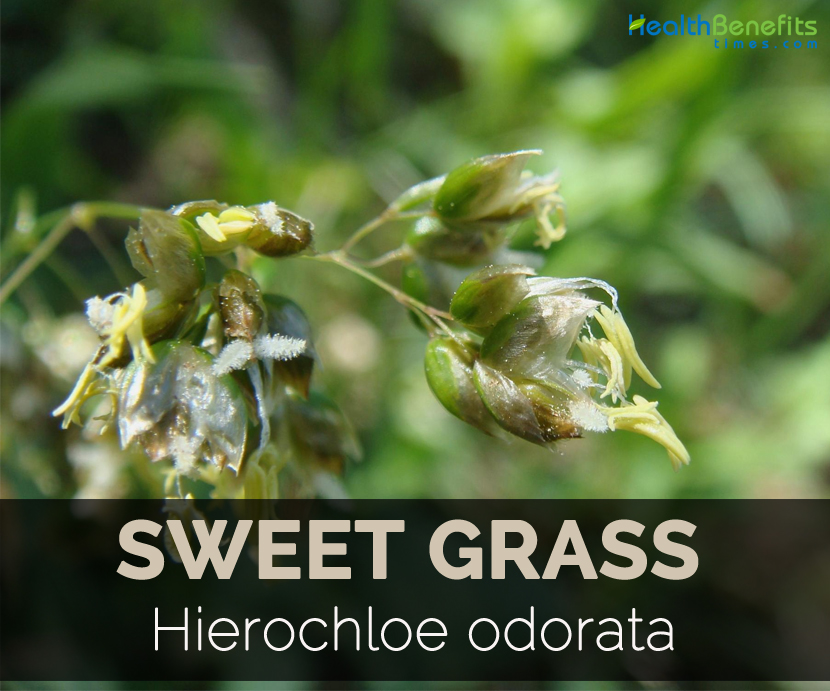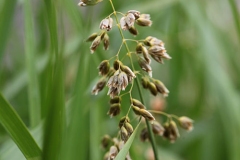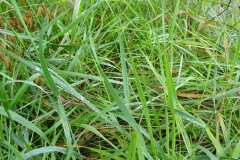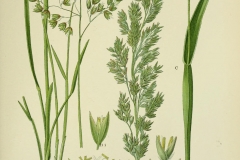Description
Sweetgrass is a fragrant, perennial and rhizomatous grass which reaches 30 inches high with hollow stems and hairless having open sheaths. Leaf blades are flat, glabrous measuring 10-30 cm. (3.9-11.8 in.) long. An inflorescence is open panicle measuring 4-9 cm. (1.6-3.5 in.) long. Lower branches are drooping to spreading. Spiklelets are three flowered: two lowest florets are staminate and uppermost is perfect. It is an early blooming plant which flowers from May to July.
Leaves
Leaf blades are flat, smooth and about 10 cm to 30 cm long. The base of leaves is hairless, broad and white colored. The underside of leaves is shiny and hairless.
Inflorescence
An inflorescence creates an open panicle about 4 cm to 9 cm long. The lower branches are spreading or drooping. Spikelets have three flowers.
Root
The plant has rhizomatous root structure. Rhizomes and roots forms a dense mat under surface of the soil.
Health Benefits of Sweet Grass
- Treat cold and cough
The herb is helpful for treating common cold as well as flu. The herbal tea of sweet grass is helpful for treating cold and fever. The tea is effective for soothing sore throat and provides relief from cough. Native Indians burn sweet grass and inhale the smoke to provide relief from cold and symptoms such as nose congestion.
- Reproductive health
Sweet grass is used by tribal people of North America to stop bleeding in uterus and to expel placenta after childbirth. The infusion made from this herb is helpful for those who suffered miscarriage.
- Eye infections
Infusion is used by native Indians as an eye wash to get rid of eye infections.
- Presence of coumarin
The compound coumarin found in sweet grass provides characteristics sweet aroma. It has blood thinning effects and used for treating certain types of edema and swelling.
- Other uses
Sweet grass provides sweet aroma when burned which is beneficial for humans. There is a belief that the herb is dried, made into bundles and burned at the beginning of ceremonies to invite good spirits and invoke their protection as well as purification. The fragrance of sweet grass will keep away the negative energy and bad spirits.
Medicinal uses
- Tea prepared from leaves provides relief from coughs and sore throats. In addition, drink the tea for venereal diseases.
- Use the sweet grass water as eyewash solution and also to heal problem such as chapping and windburn.
- Mix the sweet grass with seeds of Thalictrum occidentale for preparing tea. Drink the tea to clear congestion of nasal passages.
- After giving birth, women when drunk tea prepared from Sweet grass helps to prevent vaginal bleeding and to expel placenta.
- Leaves tea is used for treating fevers, sore throats, coughs, veneral infections and chafing.
- Soak the stems in water and use it for treating windburn, chapping and as eyewash.
- Inhale the smoke of burn leaves to treat colds.
Uses of Sweet Grass Essential Oil
- Use it as a massage oil to feel relax and leave skin moisturized and sweetly fragranced.
- It is used as a scent to create sense of calm, concentration, mindfulness, serenity and awareness of oneself.
- It is used to treat minor wounds and scrapes in order to prevent infections.
- Use the oil as a deodorizer for cars and rooms.
- Use it topically with carrier oil to soothe or heal dry and chapped skin.
- Add it to hair shampoos or conditioners to prevent scalp infections and dandruff.
- Add few drops of essential oil in bath water for relaxation.
Culinary uses
- Seeds are cooked.
- Leaves essential oil is used as a flavoring for foods in sweets and soft drinks.
- Add the leaves to vodka as a flavoring.
Precautions
- Coumarin has toxic properties that could lead to liver injury and hemorrhages.
- Use it under the supervision of health practitioner while treating any health ailments. This helps to prevent side effects.
Other uses
- This plant is used in aromatherapy.
- Due to the sweet fragrance of this plant, it is used as incense.
- The plant is used to prepare hairwash.
- It is also used for cosmetic purposes like hair and body decoration.
- The leaves of this plant were used in making baskets.
- The plant is used in manufacturing perfumes.
- The fragrant leaves of this plant are used to stuff mattresses and pillows by the Kiowa people.
- The smoke of this plant is also used to aid meditation.
Other facts
- The chemical compound known as coumarin provides a sweet fragrance to the plant.
- Native Americans use the plant for religious purposes such as calling spirits and making incense and also to aid while fasting.
- The plant encourages soporific effect which is used in meditation and shamanistic rituals having the belief that it possesses psychotropic properties.
- Use it as insect repellant in clothes cupboard.
References:
https://plants.usda.gov/core/profile?symbol=HIOD
https://pfaf.org/user/Plant.aspx?LatinName=Hierochloe+odorata
https://www.dnr.wa.gov/publications/amp_nh_hieodo.pdf?hkhyxx
https://plants.usda.gov/plantguide/pdf/cs_hiod.pdf
https://en.wikipedia.org/wiki/Hierochloe_odorata
http://www.naturalmedicinalherbs.net/herbs/h/hierochloe-odorata=holy-grass.php
http://www.valuefood.info/2065/health-benefits-of-hierochloe-odorata-holy-grass-bison-grass/
https://www.magicgardenseeds.com/The-Good-To-Know/Sweetgrass-(Hierochloe-odorata)-A.HIE02-
https://www.onlyfoods.net/sweet-grass.html
http://www.essentialoilsareus.com/sweet-grass-essential-oil/
Comments
comments
| Sweet Grass Quick Facts | |
|---|---|
| Name: | Sweet Grass |
| Scientific Name: | Hierochloe odorata |
| Origin | Northern Eurasia and North America. |



